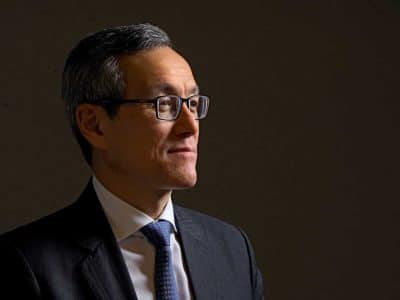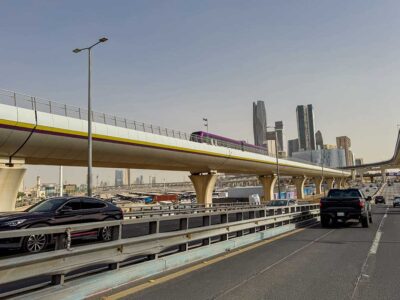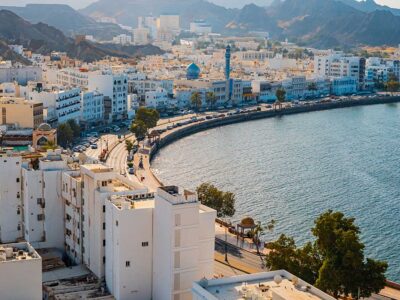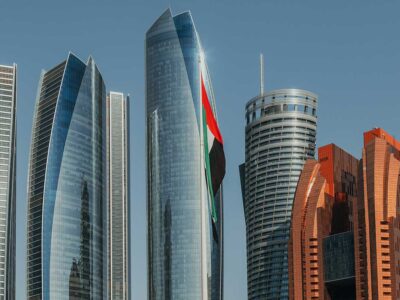Banished from Formula 1, exiting football; what’s next for sport’s most flamboyant figure? Ex-Renault boss Flavio Briatore on scandals, starting over and setting up shop in Dubai.
It doesn’t take long for flavio briatore’s famed volcanic temper to make an appearance. Squashed into a suite at the back of his new Billionaire fashion store, circled by prowling press, an inept photographer elbows over a glass of water. Seconds later, a plate clatters noisily to the floor. Ex-Formula 1 boss Briatore erupts. “Who,” he bellows, like an enraged bull, “are these f***ing hooligans?”
Wild-haired – and a little wild-eyed – Briatore doesn’t disappoint. From his blue-tinted sunglasses to his embroidered slippers, he is in person the same flamboyant, multimillionaire, supermodel-magnet of the headlines. And while he might be hotheaded, he’s also a hot ticket, bringing his Midas touch to bear on everything from football, to racing to couture clothing.
It’s the latter that has brought him to Dubai, to host the launch of his wincingly expensive men’s fashion line, Billionaire, in a franchise deal with UAE-based BinHendi Enterprises. The Dubai Mall boutique, kitted out in black leather and crystal, is one of nineteen outposts worldwide and the first in the Middle East.
The designs themselves are as subtle as the name, spanning exotic-skin shoes, jewel-encrusted jackets and peacock-patterned silk shirts. This is the label for the man who thinks Versace is understated. (It’s no coincidence the bulk of its stores are in Russia.)
So how much will it cost you to dress like a Billionaire? In a word, lots. The price tag on a long-sleeved shirt is more than $980, while a printed leather jacket clocks in at more than $5,300. A crocodile-skin jacket will set you back over $8,000, while a pair of delicately embroidered slippers – currently modelled on the feet of Briatore – are a cut above $1,000. On the heels of a banking crisis, one which Dubai has arguably felt most in the Gulf, is now really the time for selling gilt-edged garments?
Briatore, a man who, with estimated assets of $150m, is far from a billionaire himself, looks unperturbed.
“Sure, the name is a bit arrogant. Perhaps it’s not billionaire anymore; maybe its millionaire instead,” he muses, before snapping back to attention. “But it makes no difference. I believe the prices are quite normal. We start with a range from around €220 to anywhere – the shirts start at a few hundred euros. It is absolutely not just for billionaires.”
Established in 2005 with Italian designer Angelo Galasso, the label is named after Briatore’s exclusive Sardinian club, Billionaire. The 25,000 sq ft beach club each year plays host to a flotilla of princelings and super-rich celebs – handy, since a methuselah of Cristal champagne costs a reported $51,000, and mineral water is a snip at $66 a bottle. With a freshly-opened Dubai boutique and another under consideration in Abu Dhabi, are the super-rich still biting?
“We are optimistic, like with everything,” Briatore says, shrugging lightly. “I believe in life, in difficult moments, you have to work hard. Sometimes the moment is not right, the money isn’t there to invest – but I believe you have to work to the future. For us, this is the moment to invest in our brand.”
Fashion was Briatore’s passport into business. After short-lived stints as a ski instructor and travelling salesman after school, he took a job in the 1970s at the stock exchange in Milan. It was there, in 1974, that he landed his ticket to the world of the super-rich, when a meeting with clothing baron Luciano Benetton morphed into a job offer. The firm had made quick work of the retail market in Italy and France, and now had its eye on cracking the US. Briatore was eventually appointed director of Benetton’s US arm in 1979, hustling in an era of ruthless franchising that turned the clothing brand into a household name.While Briatore was rolling out stores, Luciano made the move into Formula 1, snapping up the waning Toleman team in 1985 for a few hundred thousand dollars. For Benetton, the sport spelt exposure – something that became clear when the newly named Benetton Formula 1 made its debut in luminous green cars.
Briatore saw his first Grand Prix in Adelaide, Australia in 1988. Less than two years later, he was heading the team and – having been the first to spot the potential of rising star Michael Schumacher – a familiar strutting figure in the Winner’s Circle. (Usually with a supermodel on his arm; he counts Heidi Klum and Naomi Campbell among his conquests.)
The 61-year-old Italian, however, is not your typical petrolhead. In a sport where most managers swoon over the intricacies of an f-duct system, Briatore is a cut-throat businessman first and foremost. He knows better than most that it’s the glamour that sells, not the details – an attitude that had paddock purists recoiling. As he once charmingly told a reporter: “I couldn’t tell the difference between a fuel filter and a coffee filter.”
(This is, it seems, his modus operandi. When asked the cost of the glitzy fit-out in Billionaire, Dubai, Briatore looks momentarily astonished. “I don’t f***ing know.”)
Fast-forward through a shocking 1997 season, Briatore’s dramatic exit from Benetton and – three years later – triumphant return under the Renault banner, and life last year looked good for the sport’s most flamboyant figure. Over the decade his trophy collection had expanded to include a model wife, Elisabetta Gregoraci, a multimillion-dollar yacht and – as of a $20.7m takeover in 2007 with billionaire friends Bernie Ecclestone and Lakshmi Mittal, ‘Britain’s richest man’ – football club Queen’s Park Rangers (QPR). His personal stock had never been higher.
Last September, it all changed. Ex-Renault driver Nelson Piquet Jr went public with claims that Briatore and Renault engineer Pat Symonds had ordered him to crash during the 2008 Singapore Grand Prix, in a bid to push teammate Fernando Alonso into first place. The race-fixing scandal, dubbed ‘crashgate’, rocked the industry, leading former FIA chairman Max Mosley – a man not unfamiliar with scandals himself – to brand it the “worst case of cheating in the history of sport”.
A lifetime ban, meted out by the FIA’s World Motor Sport Council, was overturned in January on appeal in France. But Briatore is still banned from the sport until 2013, and the controversy is likely to linger even longer.
Still, Briatore is a pragmatist. Asked about his ignominious exit after more than two decades in the sport, he rolls his eyes.
“Sure, I miss Formula 1. It is my old business, my baby.” He grins; “But the moment is lucky, because I just have a baby [the eight-week-old Falco Nathan, with his wife].”
There’s a brief pause in his rapid-fire English. “Look, I’m not looking for a job. I need to take care of the investments I’ve made in the last ten years – including the Billionaire brand. I’m putting myself into that.”
Not that life on the sidelines has silenced him. His chief gripe – that the sport must be show not substance – hasn’t changed.
“Formula 1 is a market,” he tells me matter-of-factly. “Little by little everyone is understanding that, from the engineers to the sponsors. We need more show and much less – well, you need the technology but it shouldn’t dominate. That was my fight for fifteen years.”In many ways, Briatore is right. The battle between rival engineers to research-and-develop themselves into pole position has sent industry costs soaring, leaving teams – even those with wealthy backers – struggling to break even. Even the more modest teams are spending $300m a year, while the biggest splash closer to $500m.
Races have been quick to mirror the money meltdown. Promoter Abu Dhabi spent a reported $45m on hosting its Yas Island race last year, reflecting a doubling of costs over five years. Two-day grandstand tickets for the city’s Grand Prix this November cost $490. Paddock Club tickets, which promise full VIP treatment, are charged at a hefty $3,942. For some punters, the sport is proving more expensive than it’s worth – average three-day attendance was down to 161, 613 in 2009 from 187,724 in 2008.
Much has been made of Briatore’s potential return to Formula 1 in 2013. Coyly, the man himself won’t rule it out. “When I stopped in 1996 I said I would never go back. I went back in 2000,” he says, rolling his eyes. “You know, life is never-say-never. I have open eyes. I still have all my friends in Formula 1 – my best friend is in [the sport], Bernie.
“But I’m not looking for a job. It’s nice to see Formula 1 from the side for once. You take away the emotion and you are a much better judge of the business.”
Still, in three years Briatore might be looking for a fresh diversion. His other passion, west London football club QPR, was shunted to the back burner in February when he resigned his position as chairman after three years.
“I didn’t walk away, I just decided to step down as chairman because, being honest, I didn’t have the time. But I still hold my [20 percent] shares,” he says.
And does he have any plans to sell them?
“No, no. I’m not in talks at the moment,” he blusters. “But everything is for sale, everything is to buy. If you sell, you sell everything, you don’t sell 20 percent.”
Showman, playboy, businessman… sidestepping Formula 1 and football, what’s next for the flamboyant Flavio? More of the same, apparently.
“I’ve worked all my life,” he says, seriously. “I’ve done it by myself. Work was my baby before. I understand there are a lot of people who are fighting to finish the month – and I don’t throw away money. It’s very important to keep both feet on the floor.”
Even those clad in $1,000 embroidered slippers.






